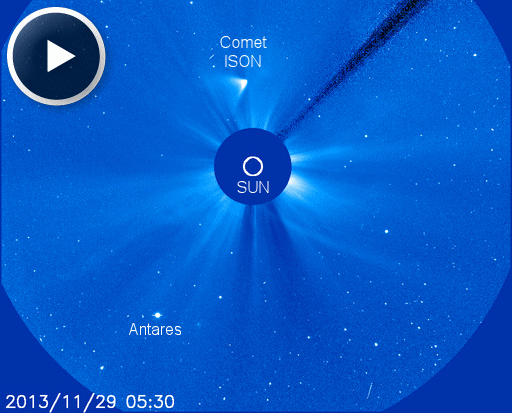COMET ISON LIVES! Cancel the funeral. Comet ISON is back from the dead. Yesterday, Nov. 28th, Comet ISON flew through the sun's atmosphere and appeared to disintegrate before the cameras of several NASA and ESA spacecraft. This prompted reports of the comet's demise. Today, the comet has revived and is rapidly brightening. Click to view a SOHO coronagraph movie of the solar flyby:
Before the flyby, experts had made many predictions about what might happen to the comet, ranging from utter disintegration to glorious survival. No one predicted both.
Karl Battams of NASA's Comet ISON Observing Campaign says, "[colleague] Matthew Knight and I are ripping our hair out right now as we know that so many people in the public, the media and in science teams want to know what's happened. We'd love to know that too! Right now, here's our working hypothesis:
"As comet ISON plunged towards to the Sun, it began to fall apart, losing not giant fragments but at least a lot of reasonably sized chunks. There's evidence of very large dust in the long thin tail we saw in the [SOHO coronagraph] images. Then, as ISON plunged through the corona, it continued to fall apart and vaporize, losing its coma and tail completely just like sungrazing Comet Lovejoy did in 2011. What emerged from the Sun was a small but perhaps somewhat coherent nucleus that has resumed emitting dust and gas for at least the time being."
Battams emphasizes that it is too soon to tell how big the remnant nucleus is or how bright the resurgent comet will ultimately become. "We have a whole new set of unknowns, and this ridiculous, crazy, dynamic and unpredictable object continues to amaze, astound and confuse us to no end. We ask that you please be patient with us for a couple of days as we analyze the data and try to work out what is happening."
Astrophotographer Babak Tafreshi has edited an HD video that compares views of ISON from both of SOHO's coronagraphs. "It seems the comet could become a naked eye object with several degrees of scattered tail by Dec 2nd or 3rd," he predicts. "It's not the comet of the century for sure, and fainter than the Lovejoy sungrazer in Dec. 2011, but an interesting imaging target is just a few nights away!" Solar flare alerts: text, voice

Solar wind
speed: 336.1 km/sec
density: 8.2 protons/cm3
explanation | more data
Updated: Today at 1736 UT
X-ray Solar Flares
6-hr max: B5 1402 UT Nov29
24-hr: C1 1006 UT Nov29
explanation | more data
Updated: Today at: 1700 UT
![]()
Daily Sun: 29 Nov 13
Sunspots AR1907 - AR1909 are growing, but they are not yet flaring. Solar activity remains low. Credit: SDO/HMI
![]()
Sunspot number: 100
What is the sunspot number?
Updated 29 Nov 2013
Spotless Days
Current Stretch: 0 days
2013 total: 0 days (0%)
2012 total: 0 days (0%)
2011 total: 2 days (<1%)
2010 total: 51 days (14%)
2009 total: 260 days (71%)
Since 2004: 821 days
Typical Solar Min: 486 days
Update 29 Nov 2013
The Radio Sun
10.7 cm flux: 133 sfu
explanation | more data
Updated 29 Nov 2013
![]()
Current Auroral Oval:
Switch to: Europe, USA, New Zealand, Antarctica
Credit: NOAA/POES
![]()
Planetary K-index
Now: Kp= 2 quiet
24-hr max: Kp= 3 quiet
explanation | more data
Interplanetary Mag. Field
Btotal: 8.6 nT
Bz: 8.3 nT south
explanation | more data
Updated: Today at 1736 UT
![]()
Coronal Holes: 29 Nov 13
There are no large coronal holes on the Earthside of the sun. Credit: SDO/AIA. ![]()





